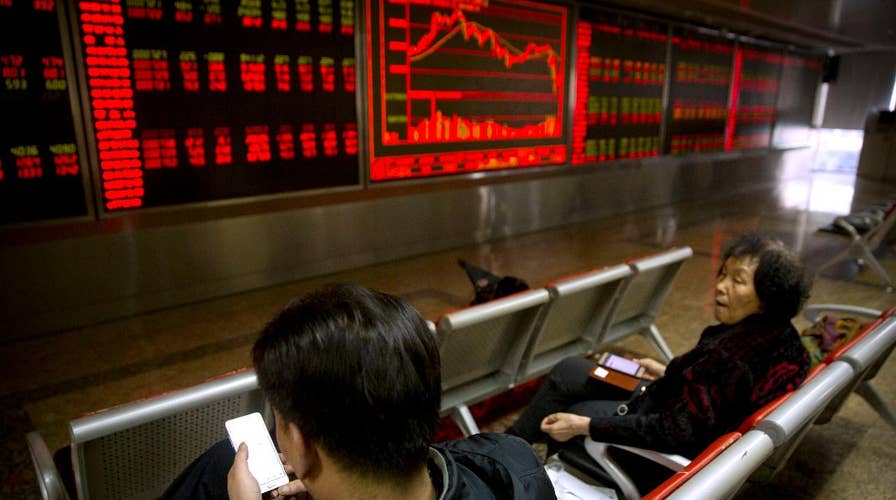Trump trade announcement rattles markets, world leaders
International markets, businesses and U.S. allies met President Trump's proposed tariffs on steel and aluminum immediately and harshly; Rich Edson reports from the State Department.
Of all the economic policies President Trump has marked for attention this year – merit-based immigration, infrastructure and vocational training – fixing the trade deficit offers the biggest bang for the buck. Cutting the $620 billion annual trade gap in half could create 2 million jobs.
Manufacturing would benefit most, and it finances two-thirds of business research and development. Investments in intellectual property for new materials, supply chain management, artificial intelligence and the like could boost long-term economic growth by a full percentage point.
China accounts for 60 percent of the U.S. trade deficit and habitually subsidizes domestic industries, limits imports in areas of rapidly advancing technology to incubate its own competitors, and forces foreign multinationals to transfer technology as a condition for market access. It compels their compliance with the Communist Party political agenda and insidious activities monitoring its citizens.
China has targeted one U.S. industry after another – metals, solar panels, computer chips and artificial intelligence – that all have significant economic and national security consequences.
Whatever the U.S. does regarding China affects our allies, and the proposed tariffs on steel and aluminum have attracted strong rebuke and threats of retaliation on our exports from our friends. Lost in all the media coverage is the fact that the World Trade Organization (WTO) agreements provide for a national security exception when the survival of critical domestic industries is threatened.
Still, rifle-shot remedies, absent a comprehensive strategy, do pose the danger of casting the Americans, not the Chinese, as malefactors in the eyes of world leaders. President Trump needs their cooperation to accomplish a radical change in commercial relations with China.
Fears of a trade war – though exaggerated – bring a new urgency to finding ways to cooperate with our allies and craft a systemic solution to the problems posed by China’s mercantilism.
President Trump has linked an exception to the tariffs on steel and aluminum for Canada and Mexico to bringing the negotiations to modernize NAFTA (the North American Free Trade Agreement) to a quicker conclusion. However, some U.S. expectations for these talks are particularly maddening – for example, that Mexico and Canada agree to eliminate arbitration panels to resolve investor disputes.
Those provisions protect U.S. companies from arbitrary foreign government actions – such as requirements to source components locally instead of from U.S. factories, coerced technology transfers and arbitrary treatment by foreign courts – and likely reduce, not increase, the U.S. trade deficit.
Coming up with a fresh approach to China, in concert with the European Union and other allies requires a wholesale rethinking of our WTO relationship with the Middle Kingdom.
The global trade body was conceived to be a club of market economies. Its dispute settlement mechanism is designed to rein in national industrial policies that occasionally harm other members – namely, discipline the venial sins of market economy governments.
China is not a market economy. It was admitted into the WTO on the premise that greater engagement with the West would accelerate market-oriented reforms, but Beijing’s success at flaunting the rules has taken it in the opposite direction.
China’s violations of WTO rules are far more sweeping than anything the dispute settlement mechanism was designed to handle. It’s time to recognize that China will never be a market economy compatible with fair competition, and Western nations would do well to impose a regime that balances its trade with the West.
The Trump administration is reported to be fashioning a broad response to China. It would do well to deal with both the investment and trade holistically.
America should impose across-the-board restrictions on Chinese investments in the United States that mirror Beijing’s policies toward U.S. investments in China.
On trade, the United States should impose a system of licenses on imports from China and encourage its allies to do the same. Exporters would be granted transferable rights to imports equal to their sales in China.
This would balance trade with China, and a system of re-sellable licenses would let the market decide which Chinese imports are most highly valued by consumers and aid U.S. exporters. And it would obviate the need of global tariffs that swipe at U.S. trading partners as well as China.
If China wants to talk trade after that we can engage Beijing in long negotiations while its businesses acclimate to being treated as their government treats U.S. businesses.

